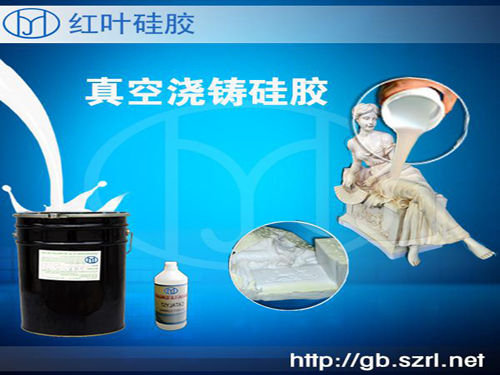
A. The definition of silicone mold mold silicone rubber is a silicone room temperature two-component mold glue, referred to as RTV. This is a two-component compound. The A component contains a cross-linking agent, and the B component contains a catalyst. The cross-linking agent and the catalyst must be separated during the packaging process. Its vulcanization is carried out at room temperature, as long as the two components are mixed according to a certain ratio (the specific ratio can be determined according to the operation time and product performance), and the two-component compound undergoes a cross-linking reaction to form a flexible, elastic colloid. Applicable to glass resin epoxy resin, Pu foam resin, plaster, cement, candles, electronics and other process plants, toy factory, electronics factory, lighting factory, silk screen factory, candle factory, production of decorative handicrafts and reproduction products, manufacturing molds.
2. Mold Silicone Rubber Molding Process (1) Raw Material Mold Silicone rubber generally consists of a base rubber, a cross-linking agent, a catalyst, and a filler. The base rubber is 107 silicone rubber, which is called hydroxy-terminated polydimethylsiloxane. This type of mold silicone rubber can be cured at room temperature, has good fluidity, no deformation, and only a slight line shrinkage. The crosslinking agent is ethyl orthosilicate. The addition of crosslinker has a significant effect on the curing time, tear strength and elongation of silicone rubber. Practice has proved that the amount of crosslinker added is 5% (mass fraction) of the base rubber. The catalyst is dibutyltin dilaurate. The amount of catalyst added has a direct relationship with the curing time. It should not be too much, generally 1% to 2% (mass fraction). Fillers include talcum powder, quartz powder and white carbon black. Talc is generally used as a filler. When using silica as a filler, there is a significant increase in mechanical strength, tear strength and uniformity.
(2) Glue mold making process Take manufacturing and replicating a Maitreya mold as an example to illustrate the rubber mold manufacturing process.
1. Select the bottom opening as the positioning part. Turn over and fill the cavity with gypsum, the height of which is about 30mm higher than the bottom, and dig out the pit for later positioning.
2. Apply plasticine. Put a piece of rice paper on the surface of the utensil, and evenly apply 5mm thick plasticine to the surface.
3. Plaster mold. In order to support and fix the RTV mold and prevent its elastic deformation, a gypsum mold is first produced outside the mud layer. According to its approximate parting surface, a piece of plaster is made, and attention is paid to the positioning between the plaster molds. The gypsum slurry is gypsum: water = 1:1.
4. RTV molding mold production. Gypsum is moulded in reverse order, the plasticine is removed, cleaned up, and the splitting agent is coated on the utensil and the plaster mould respectively, and then the mould is closed. At the same time, the components of RTV are weighed in proportions, and after mixing, they are thoroughly stirred. During the stirring process, RTV and tetraethylorthosilicate react under the action of organic tin as an accelerator to produce low-molecular-weight alcohols. When the silicone rubber is poured, pores are formed on the body of the molding die, so that the decompression takes place. Foaming is performed in a closed container with a vacuum of 100 mmHg for about 5 minutes. The silicone rubber with the air bubble was injected into the mould cavity and cured at room temperature for 24 hours. Remove the plaster caster, cut it off with a razor as intended, separate the silicone rubber from the utensil carefully, take away the utensil, and then mix the silicone rubber mold with the plaster cast as it is, mold the silicone rubber. complete.
III. Vacuum casting process 1. Configure ABS solution according to product weight (A:B=10:1)
2. Mix AB solution and degassing (operate in vacuum cabinet) Degas before and after mixing. Observe and prevent overflowing liquid when degassing. 3. Spray mold release agent into cavity of silica gel model 4. Use ABS to match climate Into the vacuum cabinet 5. Use plastic film to make the vacuum machine in the pouring channel 6. Operate the vacuum machine to perform the silicone mold casting 7. Vacuum degassing, observe whether the ABS is full of cavity, if necessary, also make up the pay 8. After the completion of the pouring, package the silica gel Mold, and sent to the oven, after a few hours of baking, ABS solution curing, you can open the mold 9. Open the mold to be careful operation to avoid damage to the silicone mold 10. For the higher requirements of the product, do plastic post-processing (sticky Knots, sanding, etc.)
The product classification, application characteristics, and precautions to distinguish between mold silicone, silicone rubber raw materials, and liquid silicone raw materials, will have their own differences. After continuous development and research, the application of silica gel in various fields of modern industry is beginning to become more widely used. The application technology and main applications of silicone raw materials and liquid silicone rubber raw materials are well known. We can find, research and explore more.
Shenzhen Hongyejie Technology Co., Ltd. is a silicone raw material manufacturer specializing in the production, development, production and sales of liquid silicone, silicone rubber, silicone materials, silicone raw materials, silicone rubber raw materials, liquid silicone raw materials and other series of silicone products.
Professional Phosphate Fertilizer manufacturer is located in China, including Monoammonium Phosphate,Powder Mono Ammonium Phosphat,Powder Mono Potassium Phosphate, etc.
accept customized formula and customized Packing Bag
Phosphate Fertilizer,Monoammonium Phosphate,Powder Mono Ammonium Phosphat,Powder Mono Potassium Phosphate
Hebei Woldi Trading Co.,LTD , https://www.woldigroup.com